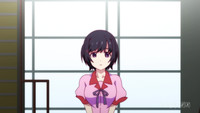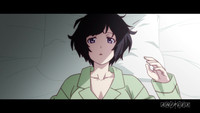The formula should seem familiar by now: 1) numbered episodes allotted for a certain feature heroine; 2) said heroine's arc is characterized by a particular animal; 3) noted animal represents an oddity of the occult that highlights a certain character flaw in the heroine; 4) enter protagonist hero who saves the damsel in distress; 5) add a little comedic banter ala-manzai-style to the mix, and; 6) a dash of fan service and panty shots for good measure. The sum total pretty much describes what the whole Monogatari franchise is all about. Even so, this current season incarnation for the Monogatari Series proves that the very same formula is anything but redundant; rather, that its content is still fresh, inventive, and purposely deep.
The continuation dubbed "second season" of the Monogatari series takes place immediately after the events of Nisemonogatari. Resident protagonist Koyomi Araragi is your typical high school student who figured in a not-so-typical turn of events when he met a vampire during the spring break of his first year. Through the help of a certain "specialist" in the occult, Koyomi's life was spared at the expense of becoming a half-vampire. Being intrinsically linked to the occult, the Monogatari series revolves around Koyomi's adventures as he gets involved within the lives of various girls that are affected by similar spiritual oddities.
 It may sound like an overly grandiose excuse for a harem show, but coming from the mind of NisiOisiN - writer of Katanagatari and the Medaka Box series - we can expect otherwise. And surely, the Monogatari Series is more than just a showcase of beautiful women (although to a certain extent it is). Beyond the show's obvious eye candy appeal and its curiously unconventional cinematic approach to visuals, it could be argued that the series is, in fact, an "mystery show" of sorts. Mystery in the sense that a certain enigmatic human emotion that gives birth to these "oddities" is brought forth as a challenge to the viewer to name. And naming is a central theme that is used by each of the characters to point towards their own identity. With much weighted focus on the use of language and semantic cues as our piecemeal clues, the Monogatari series threads together these seemingly unrelated dialogues in order to name what it is these animals actually represent for each heroine. To that end, the series is indeed purposely deep - at one point appearing nonsensical, but ultimately delivering a convincing reflection on the mystery of human emotions.
It may sound like an overly grandiose excuse for a harem show, but coming from the mind of NisiOisiN - writer of Katanagatari and the Medaka Box series - we can expect otherwise. And surely, the Monogatari Series is more than just a showcase of beautiful women (although to a certain extent it is). Beyond the show's obvious eye candy appeal and its curiously unconventional cinematic approach to visuals, it could be argued that the series is, in fact, an "mystery show" of sorts. Mystery in the sense that a certain enigmatic human emotion that gives birth to these "oddities" is brought forth as a challenge to the viewer to name. And naming is a central theme that is used by each of the characters to point towards their own identity. With much weighted focus on the use of language and semantic cues as our piecemeal clues, the Monogatari series threads together these seemingly unrelated dialogues in order to name what it is these animals actually represent for each heroine. To that end, the series is indeed purposely deep - at one point appearing nonsensical, but ultimately delivering a convincing reflection on the mystery of human emotions.
Quite ingenious of NisiOisiN, and all the more so since this type of character introspection is more apparent and developed in the current Monogatari season. This was, for example, achieved with the change in perspective to Tsubasa Hanekawa's point of view in the initial "Tsubasa Tiger" arc. In fact, this arc is by far the most progressive in terms of character development and maturation (not to mention fan service as well), which makes me hopeful for the outcome in the succeeding arcs. It comes as a shame, however, that some of the semantics intrinsic to the show's formula ends up being lost in translation. Some of the words and connections used, for example, rely heavily on cultural connotations and idiomatic expressions, making it more a loss than a gain to force such sensitivities into the English format. This doesn't mean to say that the essence is lost, however. One can still enjoy NisiOisiN's acute grasp on the Japanese language and how he uses it to throttle forward his reflections on the human creature throughout the show.
 On a lighter side, though, everything we've come to love and enjoy about the show is still present, but with a refreshing twist. For one, the fan service is still alive and as blatant as ever. What's more, rather than seeing things from Araragi's perspective, there's a heavier focus on the heroine's point of view. And last but not least, almost all of the girls sport a different hairstyle from before. The result is a wonderful intermingling of elements - both new and old - that unites to build up and enrich the ecosystem of the Monogatari series as a whole.
On a lighter side, though, everything we've come to love and enjoy about the show is still present, but with a refreshing twist. For one, the fan service is still alive and as blatant as ever. What's more, rather than seeing things from Araragi's perspective, there's a heavier focus on the heroine's point of view. And last but not least, almost all of the girls sport a different hairstyle from before. The result is a wonderful intermingling of elements - both new and old - that unites to build up and enrich the ecosystem of the Monogatari series as a whole.
New comers to the series may be taken aback by the eccentric presentation of the visuals. One must also contend with the show's assault of wordy dialogue that could border incoherent to the impatient viewer. What's more, culture-specific cues and memes may also serve as a barrier to fully understanding the context of some of the plot scenarios and themes of the show. Regardless, those tolerant enough to look past these shortcomings will be rewarded with a rich story that pays tribute to the human creature and the emotional features it has to show. Be you a vampire, tiger, lion, llama, or octopus, one can resonate with the Monogatari series' characters to a great extent. Either that or you can simply enjoy the uniqueness of the show and its avant-garde choice of presentation.
 That said, much can be expected from the show as the season unfolds. At the rate it's going, it will probably live up to those expectation and perhaps go beyond them. It goes without saying, therefore, that you can make the best out of the series by brushing up on the previous seasons that came before it. If you want to go chronologically, start with Nekomonogatari Black, followed by the original Bakemonogatari series, then Nisemonogatari. If you're really gung-ho about it, check out the original light novels and delve even deeper into the world of Monogatari. Otherwise, the current season is turning out to be quite the pinnacle of NisiOisiN's works, effectively translating into the visual format what could arguably be the most profound and deep work the author has ever written to date.
That said, much can be expected from the show as the season unfolds. At the rate it's going, it will probably live up to those expectation and perhaps go beyond them. It goes without saying, therefore, that you can make the best out of the series by brushing up on the previous seasons that came before it. If you want to go chronologically, start with Nekomonogatari Black, followed by the original Bakemonogatari series, then Nisemonogatari. If you're really gung-ho about it, check out the original light novels and delve even deeper into the world of Monogatari. Otherwise, the current season is turning out to be quite the pinnacle of NisiOisiN's works, effectively translating into the visual format what could arguably be the most profound and deep work the author has ever written to date.
The continuation dubbed "second season" of the Monogatari series takes place immediately after the events of Nisemonogatari. Resident protagonist Koyomi Araragi is your typical high school student who figured in a not-so-typical turn of events when he met a vampire during the spring break of his first year. Through the help of a certain "specialist" in the occult, Koyomi's life was spared at the expense of becoming a half-vampire. Being intrinsically linked to the occult, the Monogatari series revolves around Koyomi's adventures as he gets involved within the lives of various girls that are affected by similar spiritual oddities.
 It may sound like an overly grandiose excuse for a harem show, but coming from the mind of NisiOisiN - writer of Katanagatari and the Medaka Box series - we can expect otherwise. And surely, the Monogatari Series is more than just a showcase of beautiful women (although to a certain extent it is). Beyond the show's obvious eye candy appeal and its curiously unconventional cinematic approach to visuals, it could be argued that the series is, in fact, an "mystery show" of sorts. Mystery in the sense that a certain enigmatic human emotion that gives birth to these "oddities" is brought forth as a challenge to the viewer to name. And naming is a central theme that is used by each of the characters to point towards their own identity. With much weighted focus on the use of language and semantic cues as our piecemeal clues, the Monogatari series threads together these seemingly unrelated dialogues in order to name what it is these animals actually represent for each heroine. To that end, the series is indeed purposely deep - at one point appearing nonsensical, but ultimately delivering a convincing reflection on the mystery of human emotions.
It may sound like an overly grandiose excuse for a harem show, but coming from the mind of NisiOisiN - writer of Katanagatari and the Medaka Box series - we can expect otherwise. And surely, the Monogatari Series is more than just a showcase of beautiful women (although to a certain extent it is). Beyond the show's obvious eye candy appeal and its curiously unconventional cinematic approach to visuals, it could be argued that the series is, in fact, an "mystery show" of sorts. Mystery in the sense that a certain enigmatic human emotion that gives birth to these "oddities" is brought forth as a challenge to the viewer to name. And naming is a central theme that is used by each of the characters to point towards their own identity. With much weighted focus on the use of language and semantic cues as our piecemeal clues, the Monogatari series threads together these seemingly unrelated dialogues in order to name what it is these animals actually represent for each heroine. To that end, the series is indeed purposely deep - at one point appearing nonsensical, but ultimately delivering a convincing reflection on the mystery of human emotions.Quite ingenious of NisiOisiN, and all the more so since this type of character introspection is more apparent and developed in the current Monogatari season. This was, for example, achieved with the change in perspective to Tsubasa Hanekawa's point of view in the initial "Tsubasa Tiger" arc. In fact, this arc is by far the most progressive in terms of character development and maturation (not to mention fan service as well), which makes me hopeful for the outcome in the succeeding arcs. It comes as a shame, however, that some of the semantics intrinsic to the show's formula ends up being lost in translation. Some of the words and connections used, for example, rely heavily on cultural connotations and idiomatic expressions, making it more a loss than a gain to force such sensitivities into the English format. This doesn't mean to say that the essence is lost, however. One can still enjoy NisiOisiN's acute grasp on the Japanese language and how he uses it to throttle forward his reflections on the human creature throughout the show.
 On a lighter side, though, everything we've come to love and enjoy about the show is still present, but with a refreshing twist. For one, the fan service is still alive and as blatant as ever. What's more, rather than seeing things from Araragi's perspective, there's a heavier focus on the heroine's point of view. And last but not least, almost all of the girls sport a different hairstyle from before. The result is a wonderful intermingling of elements - both new and old - that unites to build up and enrich the ecosystem of the Monogatari series as a whole.
On a lighter side, though, everything we've come to love and enjoy about the show is still present, but with a refreshing twist. For one, the fan service is still alive and as blatant as ever. What's more, rather than seeing things from Araragi's perspective, there's a heavier focus on the heroine's point of view. And last but not least, almost all of the girls sport a different hairstyle from before. The result is a wonderful intermingling of elements - both new and old - that unites to build up and enrich the ecosystem of the Monogatari series as a whole.New comers to the series may be taken aback by the eccentric presentation of the visuals. One must also contend with the show's assault of wordy dialogue that could border incoherent to the impatient viewer. What's more, culture-specific cues and memes may also serve as a barrier to fully understanding the context of some of the plot scenarios and themes of the show. Regardless, those tolerant enough to look past these shortcomings will be rewarded with a rich story that pays tribute to the human creature and the emotional features it has to show. Be you a vampire, tiger, lion, llama, or octopus, one can resonate with the Monogatari series' characters to a great extent. Either that or you can simply enjoy the uniqueness of the show and its avant-garde choice of presentation.
 That said, much can be expected from the show as the season unfolds. At the rate it's going, it will probably live up to those expectation and perhaps go beyond them. It goes without saying, therefore, that you can make the best out of the series by brushing up on the previous seasons that came before it. If you want to go chronologically, start with Nekomonogatari Black, followed by the original Bakemonogatari series, then Nisemonogatari. If you're really gung-ho about it, check out the original light novels and delve even deeper into the world of Monogatari. Otherwise, the current season is turning out to be quite the pinnacle of NisiOisiN's works, effectively translating into the visual format what could arguably be the most profound and deep work the author has ever written to date.
That said, much can be expected from the show as the season unfolds. At the rate it's going, it will probably live up to those expectation and perhaps go beyond them. It goes without saying, therefore, that you can make the best out of the series by brushing up on the previous seasons that came before it. If you want to go chronologically, start with Nekomonogatari Black, followed by the original Bakemonogatari series, then Nisemonogatari. If you're really gung-ho about it, check out the original light novels and delve even deeper into the world of Monogatari. Otherwise, the current season is turning out to be quite the pinnacle of NisiOisiN's works, effectively translating into the visual format what could arguably be the most profound and deep work the author has ever written to date.


0 comments:
Post a Comment